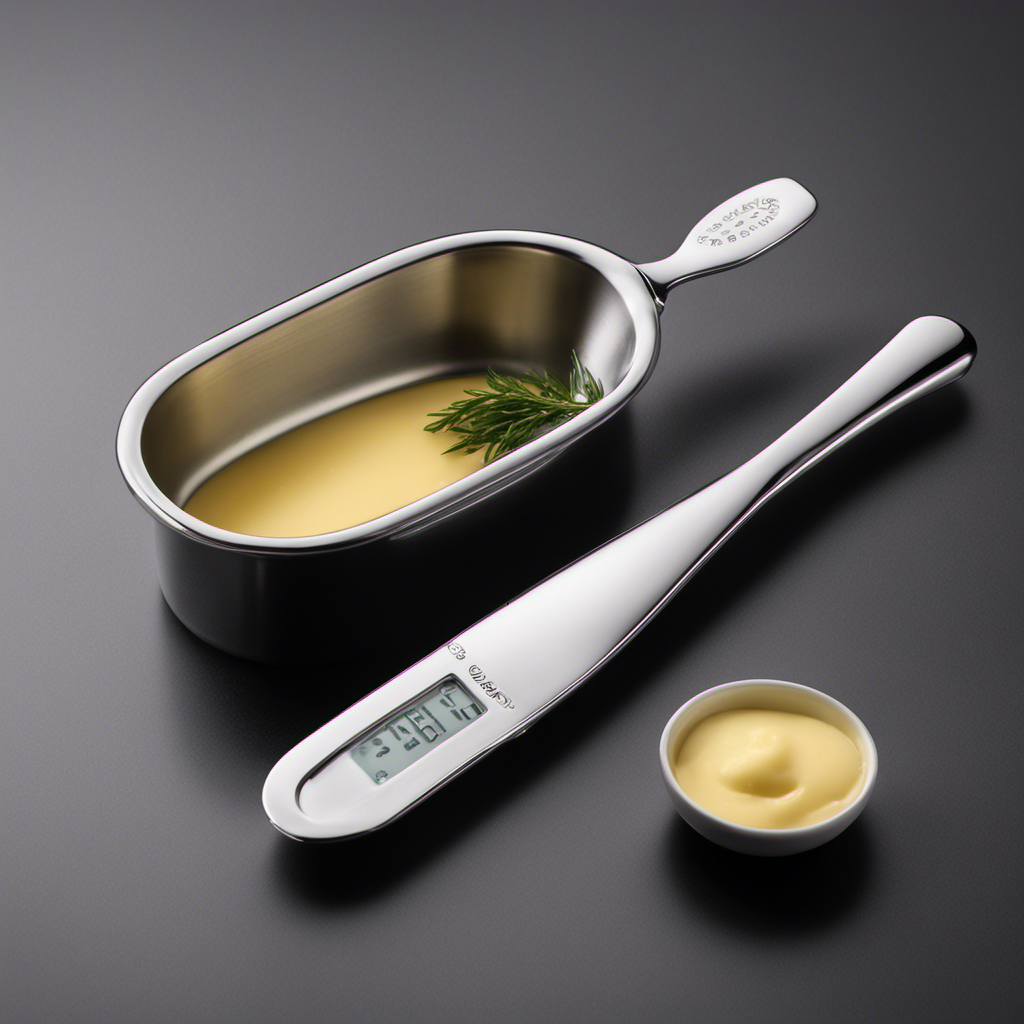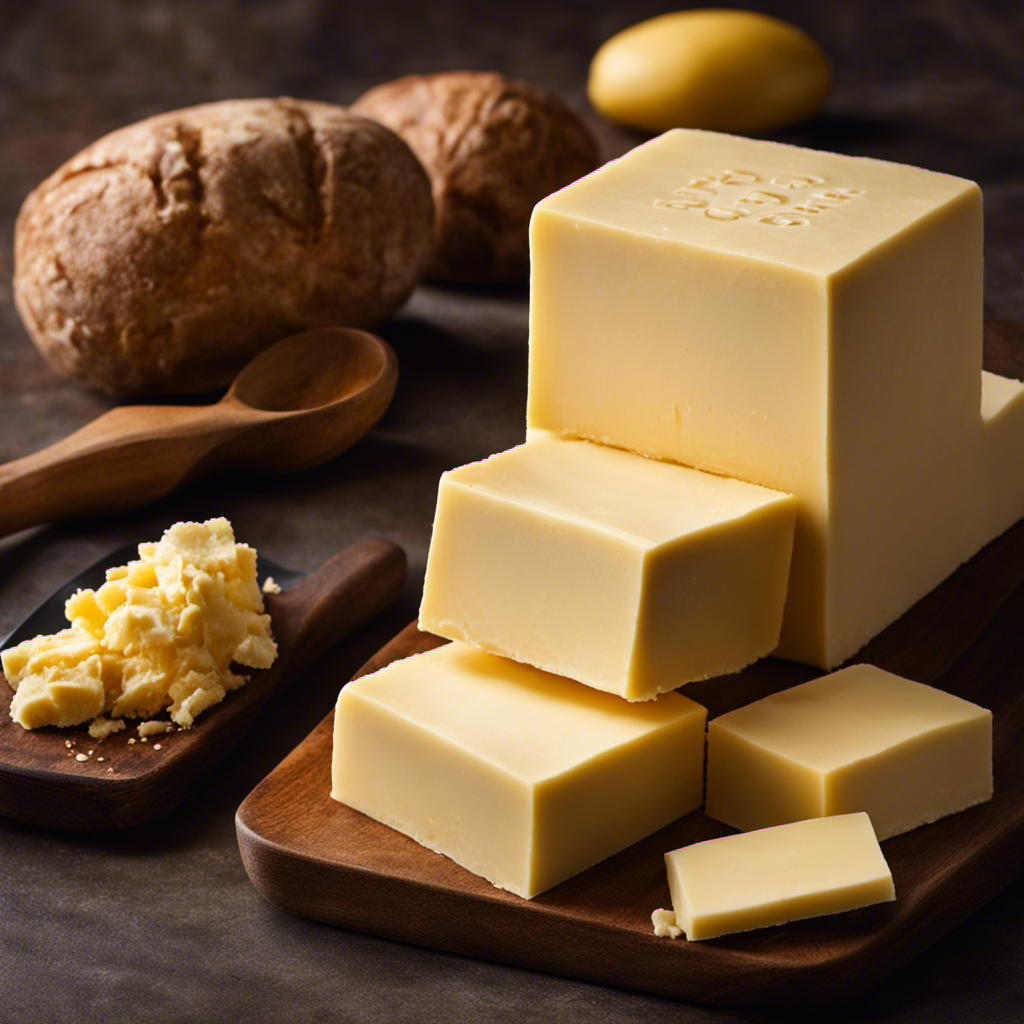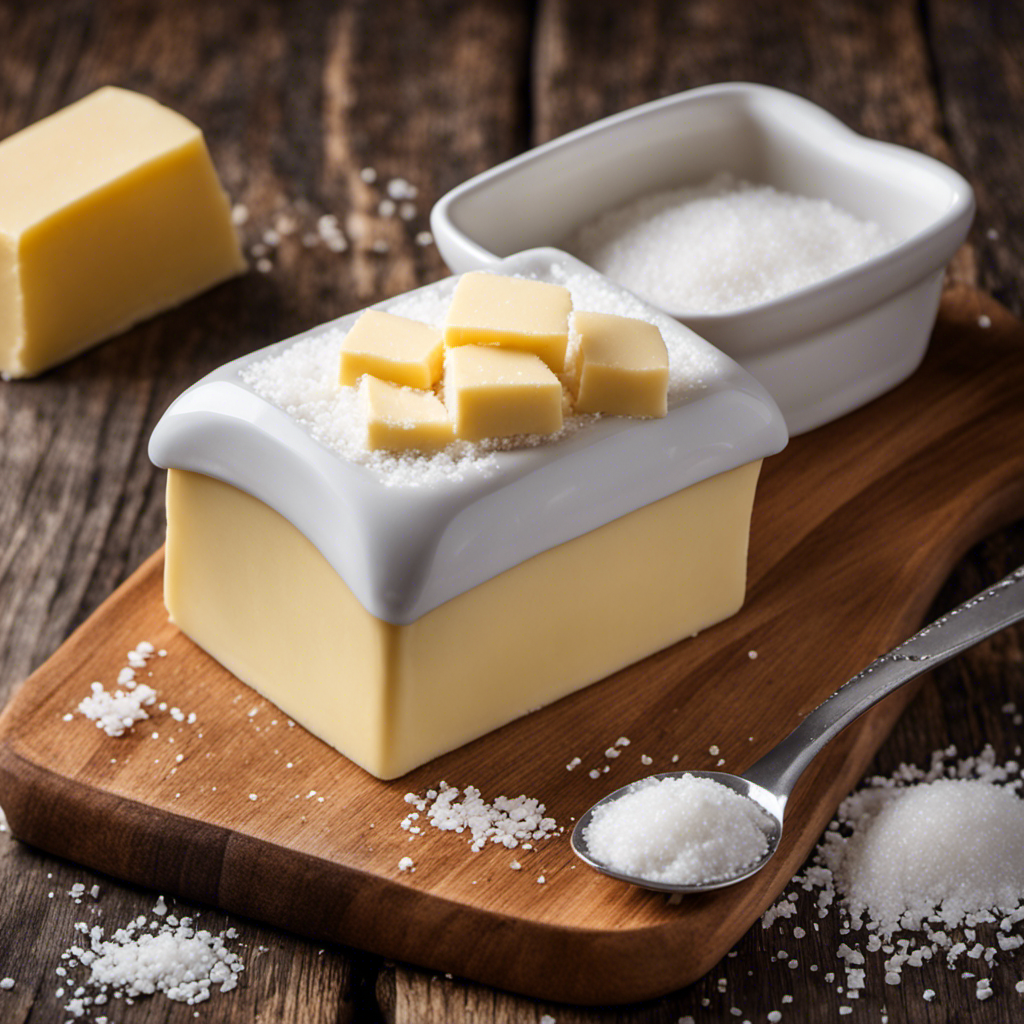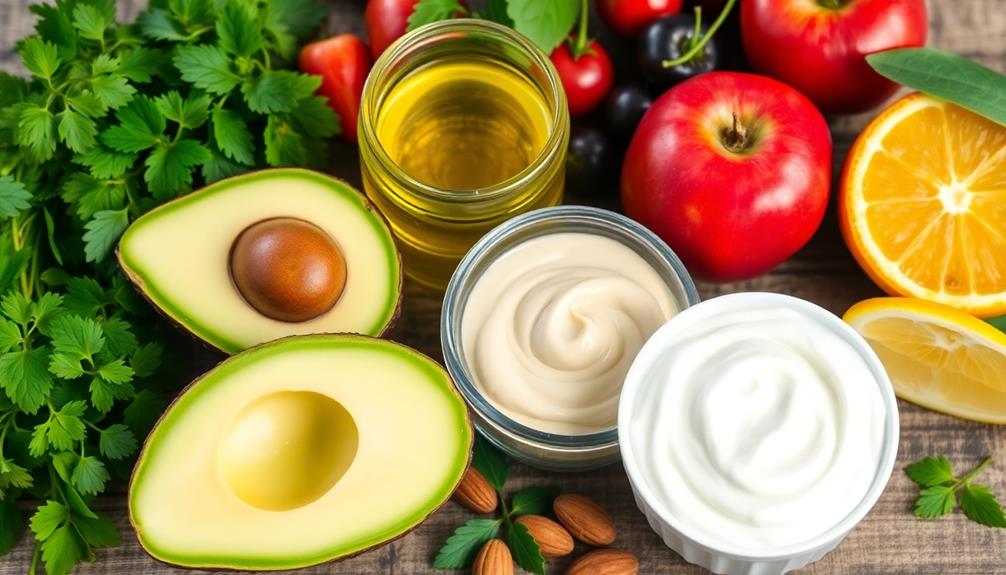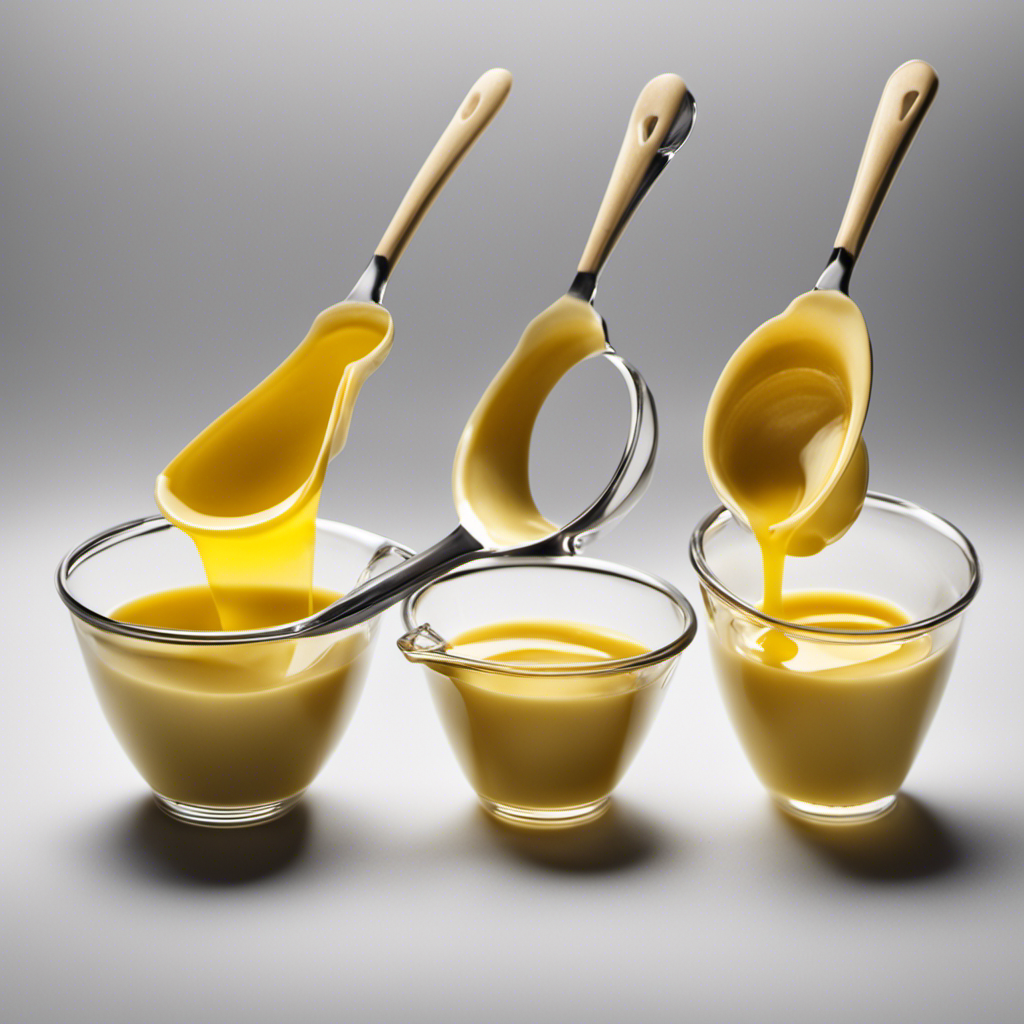Fed up with trying to guess the amount of butter your recipe calls for? Search no more! In this article, we’re going to share the definitive conversion ratio that will enable you to measure butter precisely.
Discover the secret to converting grams to tablespoons and learn how to use a tablespoon measurement effectively. Say goodbye to kitchen mishaps and confidently calculate the perfect quantity of butter.
Get ready to elevate your culinary skills with these helpful tips and tricks.
Key Takeaways
- Knowing the conversion ratio is crucial for accurate measurements
- Converting grams to tablespoons requires specific conversion factors
- Accuracy of measurement can be affected by rounding
- Different ingredients require different measuring tools
Understanding the Conversion Ratio
To understand the conversion ratio, you’ll need to know how many tablespoons are in 50 grams of butter. Converting measurements can be tricky, and there are common mistakes to avoid.
One mistake is assuming that all ingredients have the same conversion ratio. For example, converting grams to tablespoons for butter is different from converting grams to tablespoons for flour.
When it comes to converting grams to other units of measurement, it’s important to know the specific conversion factors. For instance, 1 gram of butter is equal to approximately 0.0704 tablespoons. Therefore, 50 grams of butter would be around 3.52 tablespoons.
Remember to always double-check your conversions and be aware of the different ratios for each ingredient.
Converting Grams to Tablespoons
In this discussion, we will explore the conversion ratio for butter and the accuracy of measurement when converting grams to tablespoons.
You may be wondering how many tablespoons are in 50 grams of butter, and this information will be provided.
Additionally, we will delve into the importance of accurate measurement when converting between these units to ensure precise and consistent results.
Conversion Ratio for Butter
You can easily convert grams of butter to tablespoons using a simple conversion ratio. Here is a step-by-step guide to help you calculate the conversion ratio for different butter measurements:
-
Start by determining the weight of butter in grams. Let’s say you have 100 grams of butter.
-
Find the conversion ratio for butter, which is approximately 14 grams per tablespoon.
-
Divide the weight of butter in grams by the conversion ratio. For example, 100 grams of butter divided by 14 grams per tablespoon equals approximately 7.14 tablespoons.
-
Round the result to the nearest whole number. In this case, you would have approximately 7 tablespoons of butter.
By following this conversion ratio calculation, you can easily convert grams of butter to tablespoons.
Now, let’s explore the accuracy of this measurement.
Accuracy of Measurement
The accuracy of this measurement can be determined by considering the rounding of the result.
When measuring ingredients, it is important to be aware of common mistakes that can affect the accuracy of your measurements. One common mistake is using the wrong measuring tool. Different ingredients require different measuring tools, such as cups, tablespoons, or grams.
Another mistake is not leveling off the ingredient when measuring. This can lead to an incorrect amount being added to your recipe.
Factors that can affect the accuracy of measurements include the quality of your measuring tools, the consistency of the ingredient being measured, and human error.
To ensure accurate measurements, it is recommended to use high-quality measuring tools, level off the ingredient, and double-check your measurements.
Using a Tablespoon Measurement
To convert grams of butter to tablespoons, it’s helpful to know the conversion ratio. Here’s a step-by-step guide to help you convert 50 grams of butter to tablespoons:
-
First, determine the conversion ratio. One tablespoon is equal to approximately 14.18 grams of butter.
-
Divide the weight of the butter (50 grams) by the conversion ratio (14.18 grams per tablespoon). This will give you the approximate number of tablespoons.
-
Perform the calculation: 50 grams / 14.18 grams per tablespoon ≈ 3.52 tablespoons.
-
Round the result to the nearest whole number. In this case, 3.52 tablespoons would be rounded down to 3 tablespoons.
Therefore, 50 grams of butter is approximately equal to 3 tablespoons. Keep in mind that this is an approximate conversion, as the density of butter may vary slightly.
Converting Butter Measurements
When it comes to converting butter measurements, it’s important to consider the accuracy of your conversions. Different types of butter have varying densities, which can affect the volume-to-weight ratio. To help you understand the variations, here is a table comparing the conversion of 50 grams of different butter types into tablespoons:
| Butter Type | Conversion to Tablespoons |
|---|---|
| Unsalted | 3.5 tablespoons |
| Salted | 3.75 tablespoons |
| Clarified | 4.25 tablespoons |
| Whipped | 5 tablespoons |
As you can see, the conversion accuracy varies depending on the type of butter. It is essential to use the appropriate conversion factor for your specific butter type to achieve accurate measurements. Keep in mind that these conversions are approximate and may vary slightly based on the specific brand and consistency of the butter.
Calculating Butter Quantity
Calculating how much butter you need for a recipe can be tricky, but it’s important to consider the accuracy of your conversions. Here are some tips to help you calculate the right amount of butter:
-
Understand the ratio: Different recipes may require different ratios of butter. For example, a cake recipe may call for a 1:2 ratio of butter to flour, while a cookie recipe may require a 1:1 ratio.
-
Convert measurements: Butter is often measured by weight, but recipes may call for measurements in tablespoons or cups. Use a conversion chart or online calculator to convert between grams, tablespoons, and cups.
-
Consider the texture: The consistency of butter can affect the measurement. For example, melted butter will have a different volume than solid butter. Adjust your measurements accordingly.
-
Be precise: When measuring butter, it’s important to be precise. Use a kitchen scale for accurate measurements and avoid using approximations.
Helpful Tips for Measuring Butter
By being precise and using a kitchen scale, you can ensure that your butter measurements are accurate for delicious and consistent recipes. When it comes to measuring butter alternatives or estimating the quantity of butter needed for a recipe, it’s important to have the right tools and techniques. Here are some helpful tips:
| Butter Quantity (grams) | Butter Quantity (tablespoons) |
|---|---|
| 50 | 3.5 |
| 100 | 7 |
| 150 | 10.5 |
Using a kitchen scale is the most accurate way to measure butter, as different brands and types of butter may have different densities. However, if you don’t have a scale, you can estimate the quantity using tablespoons. Keep in mind that these measurements are approximate, as the density of butter can vary. Remember to soften the butter to room temperature before measuring it for precise and consistent results in your recipes.
Conclusion
In conclusion, measuring ingredients can sometimes be a tricky task, but fear not! By understanding the conversion ratio and using a tablespoon measurement, you can easily determine the quantity of butter you need.
Remember to convert grams to tablespoons and follow our helpful tips for accurate measurements. With these techniques, you’ll be able to whip up delicious recipes without any butter-related mishaps.
So go ahead and confidently add just the right amount of butter to your culinary creations!
